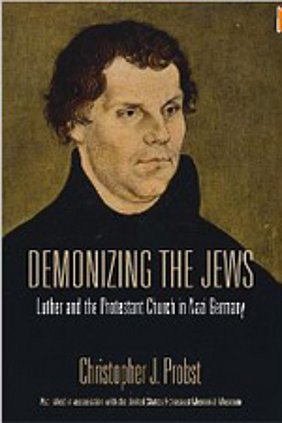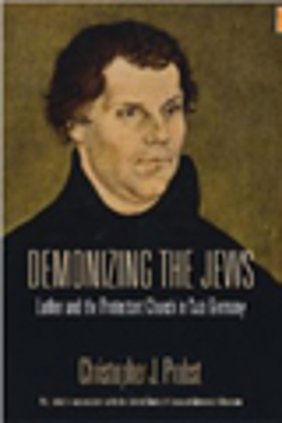It is now well understood that the German Protestant Church supported the Third Reich, despite the bitter internal conflicts of the “Church Struggle.” Together, nationalism, anti-Marxism, and antiliberalism provided the common denominator between the church and the Nazi regime, which prevented clerical and lay grievances over the regime’s interference in church affairs from developing into resistance against the regime’s racism and imperialism. Even the Confessing Church, which vehemently rejected the attempt of the overtly Nazi German Christians to “aryanize” the clergy and nazify the administration of the church, voiced few objections to Nazi anti-Jewish policy in the secular realm. Yet if Protestant complicity in the regime’s assault against the Jews is now recognized, scholars have devoted less attention to the actual content of Protestant antisemitism or what Martin Luther’s own writings on the Jews may have contributed to it. More to the point, the prevailing tendency (with some modifications) is to assume that Luther articulated a premodern, theological anti-Judaism, which bore little resemblance to the racially defined antisemitism of the Nazis.
In addition to examining Luther’s writings in their historical context, Christopher Probst investigates the works of Protestant clergy and theologians during the Third Reich to explore the Reformer’s influence on them. Following Quentin Skinner, Probst concentrates on minor figures because they provide a better understanding of the prevailing conventional wisdom. Further, Probst applies the work on antisemitism of the medievalist Gavin Langmuir, who distinguished between antisemitism (irrational thoughts about Jews that conflict with empirical observation) and anti-Judaism (nonrational or symbolic thinking about the same that constitutes an affirmation of faith). The results are first to recognize that Luther’s position on the Jews blended theologically informed denunciations of Jews with an increasingly vehement irrational antisemitism drawn from common late medieval myths and symbols. Second, the application of Langmuir’s definition complicates the claim that German Protestants’ aversion to Jews arose merely from “religious” or “premodern” anti-Judaism and not the racial or “modern” antisemitism of Nazism. Third, because Langmuir elides the chronological distance between types of hostility toward Jews, we can thus see the ways in which anti-Judaism and antisemitism have actually interacted. Probst is concerned to avoid a “Luther to Hitler” teleology, and in fact Luther’s attacks on Jews had less resonance in his own time that they would much later. Yet the author concludes that because Protestant clergy did turn to Luther to address the implications of the Nazi regime’s antisemitic policies, one can identify the links between the writings of Luther and those of Lutheran clergymen under the Third Reich.
To make his case, Probst assesses the writings of Confessing Church and German Christian theologians and pastors, as well as pastors and theologians from the unaffiliated “middle.” Not surprisingly, the three groups differed in emphasis. Thus, for example, the unaffiliated clergy dealt with Luther’s Judenschriften less frequently and directly. The groups also differed in the degree to which they incorporated irrational antisemitism, either Luther’s or their own. Confessing Church theologians and clergy either ignored Luther’s antisemitism or they used Luther’s nonrational statements to strengthen the theological legitimacy of their own views. The German Christians, on the other hand, threw caution to the wind, fully appropriating the tropes of National Socialism: the Jew as Bolshevik, international capitalist, and carrier of racial pollution. Nevertheless, the Confessing Church clergy was not above attacking “Jewish Bolshevism,” inadvertently revealing the holes in their claims to an exclusively theological position. The Württemberg pastor Heinrich Fausel personified the ambiguities in the pronouncements of the Confessing Church. Despite having rejected the German Christian attempt to introduce the “Aryan Paragraph” into the Protestant Church, and having protected a Jewish friend during the war, Fausel’s sermons betrayed the fusion of religious and secular perceptions of Judaism and Jews. His sermons combined warnings against the Jewish “foreign” threat, a subtle but unmistakably racist interpretation of the Jewish rejection of God in the Old Testament, and the appropriation of Luther’s most wrathful and xenophobic antisemitism. “A significant minority of Protestant theologians, pastors, and bishops from varying church-political and theological affiliations,” the author concludes, “consulted and expounded upon Luther’s Judenschriften. In the process, they often reinforced the cultural antisemitism and anti-Judaism of many Protestants in Nazi Germany” (p. 172).
Simply put, the complicity of the Protestant clergy with the Nazi regime did not lie in its adherence to Luther’s “two kingdoms” doctrine” that encouraged political passivity, as was once supposed. Rather, it lay in its use of Luther’s Jewish writings to inform their anti-Judaism and especially their conservatism, militant nationalism, anti-Marxism, and antisemitism. Expressing their debt to Luther by incorporating his reflections and attacks on Jews, they drew upon an intellectual pedigree that extended back well before the emergence of “modern” antisemitism, while modernizing it with contemporary antisemitic stereotypes. Among his examples, Probst could locate only one, the Marburg theologian Heinrich Hermelink, who even minimally rejected the irrational antisemitism both in Luther and in National Socialism.
Probst provides us with a detailed exegesis of each of his sources, which taken together thoughtfully challenge the supposed discontinuity between premodern anti-Judaism and modern antisemitism. Although this reviewer is not surprised by the extent of the antisemitism in Protestant circles that this book describes, the author’s focus on the use of Luther’s Judenschriften underscores its depth, particularly in the otherwise oppositional Confessing Church. If anything, Probst could have strengthened his case for the significance of his work by providing a fuller analysis of why the pronouncements of Protestant pastors and theologians should matter to us. There were occasions when the German churches did reveal the extent of their influence, thus showing us what might have been had they challenged the regime’s central goals. To be sure, as Probst recognizes, it is often difficult to prove the wider impact of theologians and clergymen, even as he suggests that they likely reinforced what many Protestants believed. Yet one only needs to recall the bitter protests of Protestant lay people over the arrest of the Lutheran bishops of Bavarian and Württemberg during the height of the conflict between the German Christians and the Confessing Church in 1934. Or , to cross confessional boundaries, we can point to the outrage of Catholic bishops, clergy, and lay people against euthanasia and the removal of crucifixes from the schools in 1941. These were mass affairs that forced the regime to retreat, at least temporarily. They were of course limited to issues that expressed communal solidarity, for nothing of the sort existed in support of the Jews. Yet they do show that the opinions of church leaders, which Probst so ably describes in the Protestant case, had serious consequences. If the SS, Wehrmacht, and civil administrations of the occupied territories played a more direct role in the Final Solution, the opinions of Lutheran theologians and clergy contributed their fair share to causing the “social death” of Jews, which laid the foundations of mass murder later.



